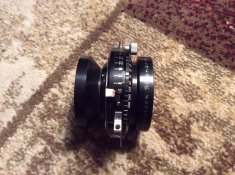I found the following data on the B&H site under “Specifications” for the lens:
Rodenstock Sironar N 180mm f/5.6
Optical Construction 6 elements in 4 groups
Aperture Range f/5.6-f/64
Covering Power 72°
Image Circle @ Infinity 262mm diameter @ f/22
Shutter Copal #1
Shutter Speed 1-1/400 sec., T,B
Flange Attachment Size 39mm dia. x 0.75mm - standard Copal #1 size
Slip-on Cap Sizes 60mm front, 51mm rear
Filter Size 58mm
Flange Focal Distance 173mm
Overall Length 57mm (2.25")
Weight 400g (14oz)
Maximum Format Size 5x7"
http://www.bhphotovideo.com/c/product/800663912-USE/Rodenstock_180mm_f_5_6_Sironar_N_Lens.html
Since the infinity flange distance is 173mm, the distance from the image plane to the rear of the attached flange (flange seated against the shoulder of the mounting thread of the shutter, and is the same as the front of the lens board) is 173mm at infinity focus. This is what you need to check. This varies with the distance focused. At closer focusing distances, the flange-to-image distance will increase (greater than 173mm).
173mm = 6.81”. That is the infinity-focus flange distance. If your lens doesn’t focus at infinity at that point, then something is wrong and you should return the lens to the seller pronto.
If the lens cells don’t look like they were tampered with, then they probably are unchanged from the original assembly. But, it is possible that someone swapped the rear cell from a different lens model—not a 180/5.6 Sironar N—into the rear of the shutter. This is the only thing that makes sense to me. That would certainly spoil the results in an unpredictable way. This COULD have happened, but isn’t likely. There wouldn’t necessarily be any visual clues if you didn’t have a complete lens side-by-side for comparison.
For reasonable accuracy, you should measure the flange distance on a camera, not simply hold the lens near a white surface as you observe the projection.





